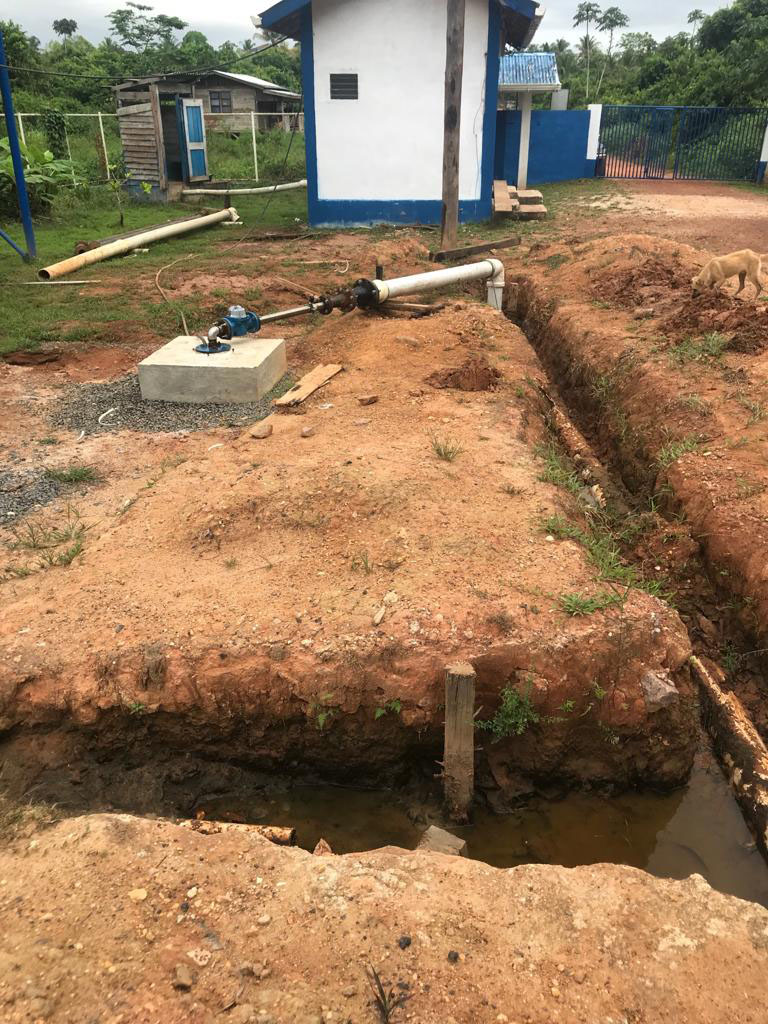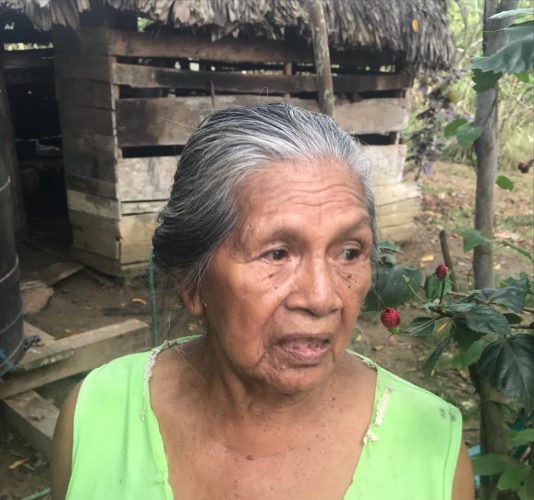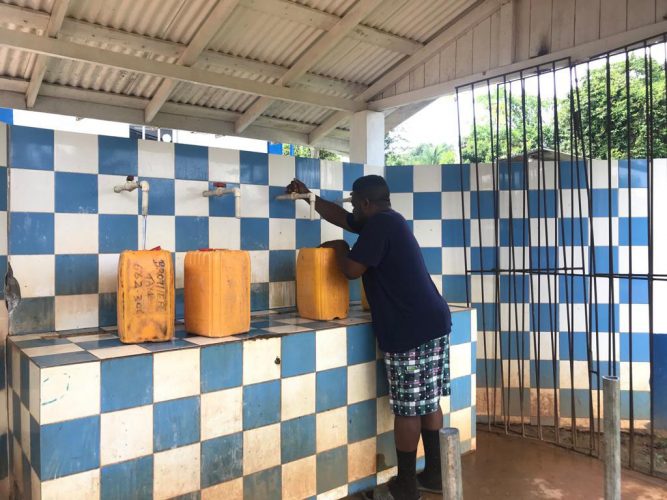Days after the Guyana Water Incorporated (GWI) temporarily halted pumping water from the Port Kaituma River due to quality concerns, a new well was put into service and fishing practices have been seen as the cause of the problems experienced.
Water returned to sections of the community on Monday afternoon. Other residents beyond central Port Kaituma remain dependent on rainfall and water suppliers in the community for water.
GWI last week issued a notice urging residents not to use the water from the river until further notice. The notice was issued after reports surfaced of dead fish in the Port Kaituma River. GWI usually pumps untreated water directly from the river into its distribution network for use by residents.
Head of Water Quality at GWI, Deon Anderson, had told Stabroek News that the company received reports of fish floating in the river and as a precaution, stopped pumping water from the river. “Samples have been collected for testing both locally and overseas and the results of these tests will determine the way forward,” he explained. The tests will include toxicity tests for heavy metals and general pathogens.
It has been determined that the water contamination resulted from traditional fishing practices by indigenous people in the riverain areas. Stabroek News was told that fish were stunned using leaves, roots and stems from a plant, a practice used during the dry season to catch fish. While the fish is safe for consumption, the water poses some risks to humans.
“The residents would pound the Canami (the leaves) in a hole and then wash it out in the water and the fishes would emerge at the top of the water. This is a normal practice during the dry weather because it is the easiest way to catch fish in the dry season,” Chairman of the Port Kaituma Neighbourhood Democratic Council, Orlando Thorne, told Stabroek News on Tuesday. He said that the substance from the leaves is poisonous to humans on consumption but does not affect the fish.
The water supplied by GWI is mainly used for domestic purposes, residents said. They explained that water for consumption is purchased or collected from the well in GWI’s compound. Some residents also depend on rainwater for consumption.
“The present water situation is because the water from the river cannot be used. They have fishes dying and if that is happening, it is not healthy. So they had to shut it (the pump) down. If we use it, we can have diarrhoea and get sick,” Burt Charles, a resident of the community explained. He said that the river would only be cleaned of the poison if “rain fall real heavy to wash out the river.”
He related that they have been experiencing water shortages for the past six days and it has been an inconvenience.
Charles said that apart from this present situation, the operations of miners in the river would also prevent them from using the river water. “A lot of miners on the river are mining for gold and chemicals from their operations come back and destroy us. We have to be careful of the fish we are eating also, because of the use of mercury in the water,” he related.
The issue of an efficient water supply is one the community, known for its mining activities, has been battling for years. “The water situation is very terrible and we need a proper water system because it is not easy. We have been suffering for years,” he stressed.
Another resident, who spoke with Stabroek News, explained that, “Water is a steady issue affecting us here. Every now and then you having an issue, sometime the pump break down or sometimes they tell you the water is too muddy because somebody had a wash down (gold recovery process in the river).”
The man told this newspaper that while GWI has been providing a better quality of water from its wells, those wells are not connected to the distribution network in central Port Kaituma. The well cannot supply the community because of the low pressure, the resident said, before referring to the service available at GWI’s compound where residents can access water.
A new well, which was dug late last year, was on Monday pressed into service and connected to the distribution network, but some residents on Tuesday said that they were still to receive water in their pipes, as the pressure was not high enough. Water from the Port Kaituma River was pumped using an independent power source, while pumping from the new well is dependent on the electricity supply, which usually runs from 3 pm to 7 am.
The business of water
With residents not equipped with the necessary tools to transport water from the well to their homes, at least two persons have cashed in on the opportunity to serve as transporters.
The men operating the delivery service would take water from the well and distribute it to persons at a cost.
“I would pay $9,000 for two black tanks and I find it reasonable. If I had to go myself it would have cost more. I would have had to hire a transportation and would have had to use bucket brigade to empty it into my tanks,” a female resident, who operates a small food stall in the community, told this newspaper. She explained that her supplier would use a canter with tanks and distribute to persons in need. “He has a setup with a pump that he can pump the water from his tanks to yours. I don’t have that setup to transfer the water into my tank, if I had collect it myself and it would have been more hard for me,” she explained.
“Water haven’t been coming through the pipes for days now and because we need it, people would go by the pump, use their transportation and bring water to people,” she added.
While Stabroek News was at the well, one of the suppliers, Jose Francis, popularly known as “Brother”, was present. He quickly explained that, “I am not selling government water, I am charging to transport it at $500 for three five gallon bottles.”
Francis, who recently gained employment as a nurse at the Port Kaituma Hospital, said he started the service while working as a taxi driver.
“I have been doing this since the year start because I realise people are in need of this service,” he said.
Being a family man and a father of four, he explained that he delivers water in the afternoons after completing his duties as a nurse. He explained that he is aware of the struggle many parents face daily to have water in their homes. “I am a parent of four and I know how important it is to have good, clean, potable water for the family. So this is why I am offering my service to the community,” he pointed out.
Another businessman has invested $6 million in a water filtration system and has been selling water to families in the community.
“The entire community does buy water from me for cooking and drinking because they cannot depend on the river water or the well. This is a business I invested $6 million in. It is a business opportunity I saw and went into it. I have my own well and filtration system. We know it is a good business, it is a business that can’t done,” he stated.
While this is the plight of residents in central Port Kaituma and surrounding areas, others beyond this catchment area face a similar situation and are heavily dependent on rainfall for their water supply. In the residential areas between One Mile and Five Miles, drums and black tanks are seen connected to gutters of homes.
Spring
Some are dependent on private springs that they have enlarged.
In Four Miles, a family has granted permission to GWI to expand their spring, where they have created a reservoir to install a solar pump and provide water to residents in surrounding areas.
Gladys Adams, the resident whose family granted permission to GWI, told this newspaper that this is not the first time they are allowing GWI to use their reservoir.
“The previous government had ask to lend them our pond. This is our personal pond but you know, we cooperate together nicely because we know the struggles for water and they put the pump there,” she said, before pointing out that it had been non-functional for some time after the water levels dropped during the dry season.
“You have to live nice with other people, you can’t say, ‘man don’t worry with them’, because what I want for my family, other people want it too,” she declared.
“It is really bad here in this small community. Oh lawd, is thousands if we have to buy water and the price is according to how you want. If you have a big family, you can’t afford,” she said, when asked to explain the water issues her community faces.
The water that will be pumped from the reservoir will be used by residents and the primary and nursery schools.
“It is going to help the school because the school don’t have water. They can’t use washrooms, they can’t clean the school and the teachers can’t clean their residence because they don’t have water,” Adams noted.
She, however, clarified that the water accessed from the pond will only be used for domestic chores, since it is not healthy to consume. As a result, they remain dependent on rainfall.
“We have to keep rain water for drinking in these black tanks. We do everything else with the pond water,” she said, before expressing uncertainty on the completion of the installation of the pump by GWI.
“I don’t know when they will come and fix the pump because everybody suffering and rain isn’t falling now,” she stressed.
Krishna David, a resident of the community and one of GWI’s contractors, told Stabroek News that the new solar pump setup will service the entire Four Miles and surrounding areas.
“We cleaned up this spring a few days ago and they are supposed to come and install a submersible pump. We had to dig this well 15 feet deep because of the dry weather and this is the only form of relief for them,” David explained. He noted that the new water supply system should be up and running within three days and related that an iron scaffold is being constructed to support the pump that will be installed.
Meanwhile, David explained that the new GWI well that was put into service will soon be connected to an expanded water distribution network to bring further relief to residents.
He stated that the new system should have enough pressure to send water through the main to the different residential areas in Port Kaituma.













